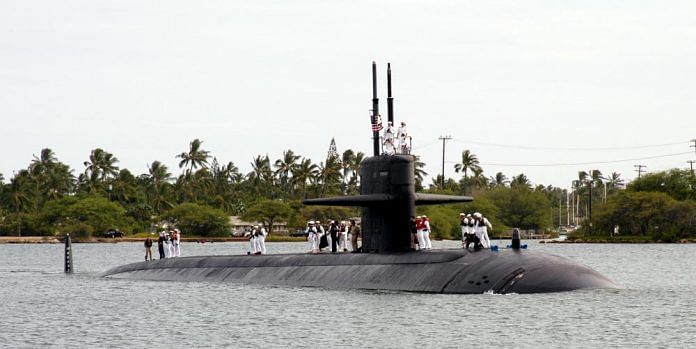
What are nuclear-powered submarines that Australia will acquire under first AUKUS initiative
Only six countries currently operate nuclear-powered submarines — China, France, India, Russia, the UK and the US.
19 September, 2021 8:00 am IST
A US nuclear-powered submarine (representational image) | Wikimedia commons
New Delhi: The US and UK are set to provide Australia with the technology to deploy nuclear-powered submarines, as part of the first initiative under the new trilateral security partnership AUKUS.
“Under AUKUS, the three nations will focus immediately on identifying the optimal pathway to deliver at least eight nuclear-powered submarines for Australia,” read a statement by the Australian government Thursday.
“Over the next 18 months, Australia, the UK and US will intensely examine the full suite of requirements that underpin nuclear stewardship and demonstrate a clear pathway to becoming a responsible and reliable steward of this sensitive technology,” the statement added.
However, this move has drawn criticism from both China and France. According to China, the agreement could damage regional peace and stability while France accusedthe US of “stabbing it in the back” since the AUKUS partnership led to the scrapping of a historic $66 billion deal between France and Australia to build 12 Barracuda submarines, which was signed in June 2016.
The AUKUS agreement led to the scrappingof a historic $90 billion deal between France and Australia for nuclear-powered submarines.
ThePrint explains what nuclear-powered submarines are and the advantages of these submarines in a country’s fleet.
A nuclear-powered submarine, as the name suggests, is powered by a nuclear reactor but it is not a nuclear weapon.
Every nuclear-powered submarine draws from its own miniature nuclear reactor onboard, which is typically fuelled with uranium, according to a report in The Conversation. For such a reactor to work, uranium has to be ‘enriched’ to contain 50 per cent of a key isotope, uranium-235.
Natural uranium consists of approximately 99.3 per cent of the isotope uranium-238 and only 0.7 per cent of uranium-235. The process of enrichment can be carried outthrough gaseous diffusion, gas centrifuges or laser isotope separation.
According to the Australian government statement, “Nuclear-powered submarines do not have the same limitations that face conventional submarines on weapons storage, speed and endurance.”
“They can stay completely submerged for many months, limiting the opportunities for detection by adversaries.”
Only six nations own and operate these submarines currently: China, France, India, Russia, the UK and the US.
Types of nuclear-powered submarine ships
Nuclear-powered submarines can be divided into three broad categories — the nuclear-powered fast-attack submarines or SSNs, the nuclear-powered ballistic submarines or SSBNs and the nuclear-powered cruise missile submarines or SSGNs.
SSNs are the oldest type of nuclear-powered submarines and the first of these, the American-made Nautilus, was deployedin 1954 by the US. The Soviet Union, meanwhile, launched SSGNs in the late 1960s.
Unlike the standard SSN nuclear submarines, SSBNs and SSGNs are capable of firing ballistic missiles and cruise missiles, respectively.
The US currently operates three classes of SSNs — the Los Angeles, the Seawolf and the Virginia. The currently operational US SSBNs fall under the Ohio class, some of which were converted into SSGNs.
While the Los Angeles class was first built in 1982 and equipped with a vertical launch missile system with twelve launch tubes, the Seawolf class was commissioned in 1997 and represented greater maneuverability than the Los Angeles class, among other advancements.
The Virginia class is the newest American-made SSN and is a smaller attack submarine than the Seawolf class and was first commissioned in 2004. The Ohio class, meanwhile, was first built in 1981 and its fleet was restricted to a total of 14 by 2002.
The UK operates two classes of SSNs — Trafalgar ( with five 533 mm torpedo tubes) and Astute (with six torpedo tubes) —and a single class of SSBNs, the Vanguard, which contains four torpedo tubes.
Australia will be acquiring the technology for and building eight SSNs, according to a report from the International Institute of Strategic Studies.
India and the nuclear submarine industry
India entered the nuclear-powered submarine fray in the late 1980s with the Chakra, an SSN on lease from the Soviet Union.
The original INS Chakra initially came to India on a three-year lease that began in 1988. Chakra II was inducted in 2012 and returned to Russia in June this year after its lease expired
Currently, India has a single Akula-class SSN in service, which was leased from Russia in 2011, and two Arihant-class SSBNs, the first of which was cleared for operations in 2016.
But more are on the way, with another Russian Akula-class SSN due for arrival in 2025, six submarines to be built as part of Project 75 and a new S5-class of SSBNs.
No comments:
Post a Comment